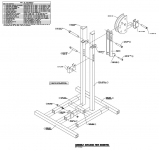


Instead, they looked to the American bikes they knew and loved and sought ways to improve their performance. But there was a decade or two’s production of Harley overhead valve and Flathead Big Twins on the road (1936 was when the OVH Knucklehead 61” EL was introduced, as well as the 74” and 80” Flathead U series bikes) and there were also many many surplus Flathead 45” WLAs war bikes to be had for as little as $50, and lots of folks just didn’t take to the imports. Harley introduced the K-Model in 1952 to compete in TT races and on the flat track, and in 1957 added an overhead valve top end, and the Sportster was born.


Imported British TT bikes were quicker and lighter than the Harleys and Indians on the road, both Flathead and overhead valve models, and by the 1950s, the Triumph twins were hard to beat in a street race. Performance parts just weren’t widely available to Harley owners at the time. Performance modifications in the late 40s and 50s often meant grinding your own cam profiles or adapting side draft carburetors from small import cars (American cars used down draft carbs, and the Harley and Indian side draft, so side draft carbs from British cars – the SU, and German cars – the Weber, became performance options for American bike builders). The chopper didn’t spring into existence from nothing, however, it evolved from the bikes of the 40s and 50s that were the first “bobbers,” a term that is horribly misunderstood today. They were the “thing” in the 60s and 70s, and the more radical the better, until they kind of disappeared from the scene by the end of the 80s except in Sweden, of all places, where they took the ball and ran with it, creating the “Swedish style.” But we loved ‘em, just the same, and a new generation of bikers and builders have discovered the chopper as a form of creative expression with a vengeance. But they looked wonderful as objects d’art, if not examples of superior craftsmanship and creativity. 1970's Chopper Generator Shovelhead Motor with Gooseneck Frame Mods and Molded Gas Tank - image via RetrospaceĬonsider the classic Harley chopper, a motorcycle which has been modified heavily from stock, primarily to remove bulky fenders and trim in favor of light, slimmer options, to change the steering angle and frame geometry, with wheel, fork, and gas tank choices made in such a way as to lengthen and narrow the bike, creating a longer bike that, yes, didn’t handle as well as the original, and often was considerably less comfortable and didn’t necessarily stop as well.


 0 kommentar(er)
0 kommentar(er)
